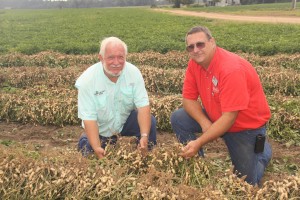 After finishing up lunch at UGA’s Southeast Research and Education Center, tour participants continued their trek to the land of onions. Wait a minute. This is supposed to be the Peanut Tour. What are we doing visiting an onion area? Well, since Georgia is known for its sweet onion, the Vidalia Onion, it is only fitting to learn a little about Georgia’s famous tear-jerker while in this part of the state.
After finishing up lunch at UGA’s Southeast Research and Education Center, tour participants continued their trek to the land of onions. Wait a minute. This is supposed to be the Peanut Tour. What are we doing visiting an onion area? Well, since Georgia is known for its sweet onion, the Vidalia Onion, it is only fitting to learn a little about Georgia’s famous tear-jerker while in this part of the state.
Tour attendees arrived at Vidalia Valley in Lyons, Georgia. Vidalia Valley is owned by the Stanley family, which is a 6th generation family of Georgia farmers. Brian, R.T. Jr., Tracy and Vince are the current generation to grow the business from a local, seasonal farm to a year-round, multi-location and multi-functional group of integrated businesses. They not only grow the country’s famous Vidalia Onions, they farm over 4,000 acres of other vegetables and row crops. Vidalia Valley, the processing facility, bottles thousands of cases and millions of pounds of peeled and diced onions including reds, whites and yellows, each year. Vidalia Onion Farms, IQF facility, freezes millions of pounds of diced onions, carrots and sweet potatoes each year. Vidalia’s Best, the fresh produce facility, grows and distributes fresh cucumbers, melons and sweet potatoes. When it comes to fresh and processed produce, the Stanley’s and their integrated business are your East coast source for ‘Farm Direct Made Easy.’
During the tour of Vidalia Valley, tour participants were given a tour of the facility. At this particular facility, onions grown by Stanley Farms, as well as outsourced onions are shipped in, peeled and sent into manufacturing or further processing. During Vidalia Onion season, which runs from April to August, representatives from Vidalia Valley said they ship out 40,000 pounds a day of whole, peeled onions. Through Vidalia Valley’s processing facility, products such as relishes, salsas, dressings, vinaigrettes, jams, jellies, specialty items, barbeque and hot sauce, as well as organic products are created. Many of the products can be found on Vidalia Valley’s website, vidaliavalley.com, and some are created for other restaurants and retailers. Vidalia Valley even develops peanut related products for consumers, such as a Thai peanut sauce and a peanut butter barbecue sauce for Paula Dean. Click here for one of Paula’s recipes using the peanut butter barbecue sauce!
View the 2014 Georgia Peanut Photo Album.
 The last field stop on the 2014 Georgia Peanut Tour allowed attendees to see harvest up close at the farm of Hub Daniel in Tattnall County. At earlier field stops the ground was too wet for farmers to demonstrate peanut digging or picking. Daniel is a fifth generation farmer and has been farming for 34 years. He grows 2,700 acres of peanuts, corn, soybeans, cotton, wheat, rye and pecans. Check out this video where WTOC recognized Hub Daniel. While at the farm, attendees were able to see Daniel harvest his peanuts with a KMC combine and continue to pick peanuts by using KMC’s unload on-the-go. This option saves farmers time loss to dumping by allowing continuous harvesting.
The last field stop on the 2014 Georgia Peanut Tour allowed attendees to see harvest up close at the farm of Hub Daniel in Tattnall County. At earlier field stops the ground was too wet for farmers to demonstrate peanut digging or picking. Daniel is a fifth generation farmer and has been farming for 34 years. He grows 2,700 acres of peanuts, corn, soybeans, cotton, wheat, rye and pecans. Check out this video where WTOC recognized Hub Daniel. While at the farm, attendees were able to see Daniel harvest his peanuts with a KMC combine and continue to pick peanuts by using KMC’s unload on-the-go. This option saves farmers time loss to dumping by allowing continuous harvesting.





 Use of technology on the farm was the main focus of this tour stop at Boddiford’s farm. Boddiford pointed to a 1962 John Deere 3010 tractor that Boddiford started farming with in 1974. His father originally purchased the tractor in 1962. Boddiford farmed with the 3010 for a number of years and needed a new tractor in the 1990s so he sold it but later regretted it. After many years, Boddiford saw a John Deere 3010 tractor at an auction in South Carolina, recognized it as the tractor he had sold earlier so he purchased it again from the auction for more money than he originally sold it for. Today, Boddiford has told his son that the 3010 tractor is one piece of equipment he can’t sell.
Use of technology on the farm was the main focus of this tour stop at Boddiford’s farm. Boddiford pointed to a 1962 John Deere 3010 tractor that Boddiford started farming with in 1974. His father originally purchased the tractor in 1962. Boddiford farmed with the 3010 for a number of years and needed a new tractor in the 1990s so he sold it but later regretted it. After many years, Boddiford saw a John Deere 3010 tractor at an auction in South Carolina, recognized it as the tractor he had sold earlier so he purchased it again from the auction for more money than he originally sold it for. Today, Boddiford has told his son that the 3010 tractor is one piece of equipment he can’t sell.